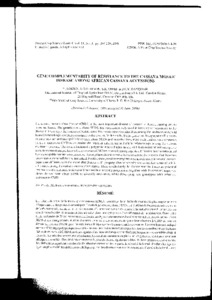| dc.contributor.author | Lokko, Y. |
| dc.contributor.author | Dixon, Alfred G.O. |
| dc.contributor.author | Offei, S.K. |
| dc.contributor.author | Danquah, E.Y. |
| dc.date.accessioned | 2019-12-04T11:18:08Z |
| dc.date.available | 2019-12-04T11:18:08Z |
| dc.date.issued | 2006 |
| dc.identifier.citation | Lokko, Y., Dixon, A.G., Offei, S.K. & Danquah, E.Y. (2006). Gene complementarity of resistance to the cassava mosaic disease among African cassava accessions. African Crop Science Journal, 14(3), 207-220. |
| dc.identifier.issn | 1021-9730 |
| dc.identifier.uri | https://hdl.handle.net/20.500.12478/3063 |
| dc.description.abstract | The cassava mosaic virus disease (CMD) is the most important disease o1'cassava in Africa, causing severe economic losses. The genetic stock, clone 58308, has been extensively used in breeding for resistance to the disease, but recently, other sources o1'resistance to the disease have been identified among the landraces and could be used in breeding to diversity resistance to the disease. In this study, the progenies o1'70 segregating F, crosses of some resistance and susceptible landraces, clone 58308 and its derivatives, were evaluated in 3 environments for their reaction to CMD to determine the mode of inheritance and allelic relationships among the various resistant accessions. The result indicated a polygenic mode of inheritance, with both resistant and susceptible accessions contributing effective factors towards CMD resistance in their progenies. Effective factors contributed by the susceptible parents were recessive. Among the resistant accessions, the results further showed that the genes for resistance are nonallelic and not linked. Positive transgressive segregants were also detected in several crosses. Significant differences in the mean distribution of progeny disease severity scores further revealed allegic differences among the various sources of resistance. These results imply that the resistant landraces are potential new sources of resistance, which could be used in a breeding programme, together with the resistant improved clones derived from clone 58308 to diversify resistance, while developing new genotypes with enhanced resistance to CMD. |
| dc.description.sponsorship | Rockefeller Foundation |
| dc.language.iso | en |
| dc.subject | Cassava Mosaic Virus Disease |
| dc.subject | Clone |
| dc.subject | Resistance |
| dc.subject | Landraces |
| dc.subject | Genotypes |
| dc.title | Gene complementarity of resistance to the cassava mosaic disease among African cassava accessions |
| dc.type | Journal Article |
| dc.description.version | Peer Review |
| cg.contributor.affiliation | International Institute of Tropical Agriculture |
| cg.contributor.affiliation | University of Ghana |
| cg.coverage.region | Africa |
| cg.coverage.region | West Africa |
| cg.coverage.country | Nigeria |
| cg.coverage.country | Ghana |
| cg.authorship.types | CGIAR and developing country institute |
| cg.iitasubject | Cassava |
| cg.iitasubject | Farm Management |
| cg.iitasubject | Livelihoods |
| cg.iitasubject | Plant Genetic Resources |
| cg.iitasubject | Plant Breeding |
| cg.iitasubject | Pests Of Plants |
| cg.iitasubject | Handling, Transport, Storage And Protection Of Agricultural Products |
| cg.iitasubject | Land Use |
| cg.iitasubject | Genetic Improvement |
| cg.iitasubject | Plant Diseases |
| cg.iitasubject | Plant Production |
| cg.iitasubject | Disease Control |
| cg.accessibilitystatus | Limited Access |
| local.dspaceid | 94529 |

